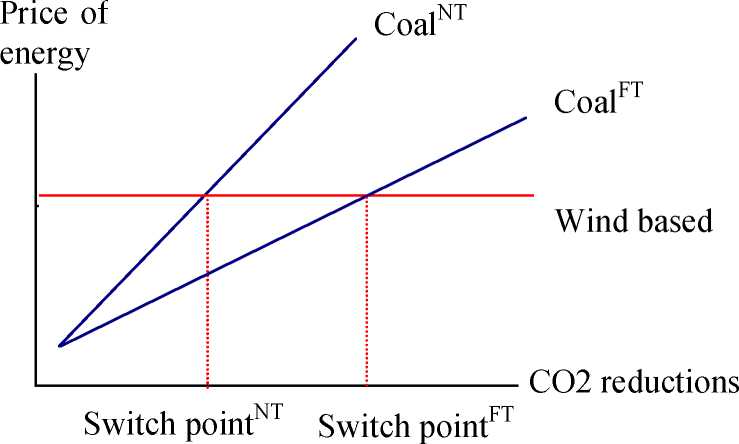fossil fuel based energy production will face rising marginal costs as we as-
sumed in figure 1.
The switch point approach can also yield valuable insights into how different
policy options influence the timing of switch points. To illustrate this point, fig-
ure 2 shows a situation where only two possible types of energy production ex-
ist, coal fired and wind-based. Here we compare two policy options, a fully
flexible situation, where no restriction on international trade in permits exists,
and one where only domestic emission reductions are allowed. CoalNT identifies
the price of energy produced by coal in a non-trade scenario, while CoalFT is
defined as the coal based energy price in a full trade situation. Obviously, wind-
based energy production becomes competitive compared to coal-based energy
production at a lower emissions-reduction level in a non-trade situation.
Figure 2: Change in relative prices from different reductions policies

How does the appearance of first mover advantages relate to the switch-points?
The appearance of technological improvements on non-renewable energy
sources also changes the switch points, but now in all countries that can inte-
grate the new technology into their energy supply sector less cheaply than with-
16
More intriguing information
1. The name is absent2. Business Cycle Dynamics of a New Keynesian Overlapping Generations Model with Progressive Income Taxation
3. Strengthening civil society from the outside? Donor driven consultation and participation processes in Poverty Reduction Strategies (PRSP): the Bolivian case
4. MATHEMATICS AS AN EXACT AND PRECISE LANGUAGE OF NATURE
5. The name is absent
6. The name is absent
7. Regional dynamics in mountain areas and the need for integrated policies
8. Spatial Aggregation and Weather Risk Management
9. Anti Microbial Resistance Profile of E. coli isolates From Tropical Free Range Chickens
10. The name is absent